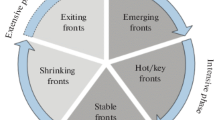Abstract
The concept of entropy well-know in information theory and thermodynamics is applied in the fields of scientometrics and innovation research in order to introduce an indicator for the institutional involvement in of the location of research and development. By means of this concept four applications in the fields of research and national technology policy, industrial technology management, and innovation research are outlined. First, the national institutional structures in telecommunications research and development in Japan are compared to those of the Netherlands. It is concluded that the institutional involvement is not always more random in a larger country but rather depends on the disaggregation into fields and subfields. Secondly, broad versus narrow national technology strategies in the so-called “high technologies” are compared for various OECD and COMECON countries. Thirdly, corporate R & D strategies of Japanese telecommunication companies are studied. Fourthly, for selected R & D-intensive technologies it is shown that with the progress of time the involvement of industrial branches in a new technology fluctuates. The four analyses are based either on bibliometric or on patent data. The usefulness of the concept of entropy in scientometrics and innovation research is assessed through these examples.
Similar content being viewed by others
References
R.P. Feynman, R.B. Leighton, M. Sands,The Feynman Lectures on Physics, Reading, Mass., Addison-Wesley, 1971.
P.P. Saviotti, Information, variety and entropy in technoeconomic develop-ment,Research Policy, 17 (1988) 89.
C.E. Shannon, W. Weaver,The Mathematical Theory of Communication, Urbana, University of Illinois Press, 1949.
F. Kodama, Dynamics of National R & D Program, Research on Socio-Economic Aspects of Energy Systems, Tokyo, Ministry of Education, Science and Culture, 1987.
H.P.F. Peters, D. Hartmann, A.F.J. Van Raan, Monitoring advances in chemical engineering,Informetrics,L. Egghe,R. Rousseau (Eds), Amsterdam, Elsevier, 1988, pp. 175–195.
H. Grupp, U. Schmoch, Technologieindikatoren: Aussagekraft, Ver-wendungsmöglichkeiten, Erhebungsverfahren,Handbuch — Organisation und Technik der Kommunikation,H.J. Bullinger (Ed.), München, Beck, 1989.
U. Schmoch, H. Grupp, Patents between Corporate Strategy and Technology Output: An Approach to the Synoptic Evaluation of US, European, and West German Patent Data, Proceedings of the workshop on “Science Indicators: Their Use in Science Policy and their Role in Sciences”, Leiden, D.S.W.O. Press, 1989.
U. Schmoch, H. Grupp, W. Mannsbart, B. Schwitalla,Technik-prognosen mit Patentindikatoren, Köln, Verlag TÜV Rheinland, 1988.
S. Hauser,Statistische Verfahren zur Datenbeschaffung und Datenanalyse, Freiburg, Verlag Rombach, 1981.
H. Legher, West German competitiveness of technology-intensive products,Problems of Measuring Technological Change,H. Grupp (Ed.), Köln, Verlag TÜV Rheinland, 1987, pp. 171–190.
H. Grupp, H. Legler,Strukturelle und technologische Position der Bundes-republik Deutschland im internationalen Wettbewerb, Final Report, Karlsruhe & Hannover, 1989.
R. Johnston, J. Hartley, Formulation and Development of High Technology Indicators, Final Report, Centre for Technology and Social Change, University of Wollongong/Australia, 1986.
Telecom R & D: From Chips to Satellites,The Oriental Economist, 8 (1985) 35.
H. Grupp (Ed.),Problems of Measuring Technological Change, Köln, Verlag TÜV Rheinland, 1987.
H. Grupp, O. Hohmeyer, R. Kollert, H. Legler,Technometrie — Die Bemessung des technisch-wirtschaftlichen Leistungsstands, Köln, Verlag TÜV Rheinland, 1987.
Author information
Authors and Affiliations
Rights and permissions
About this article
Cite this article
Grupp, H. The concept of entropy in scientometrics and innovation research. Scientometrics 18, 219–239 (1990). https://doi.org/10.1007/BF02017763
Received:
Issue Date:
DOI: https://doi.org/10.1007/BF02017763




